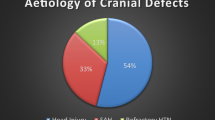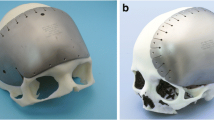Abstract
Background
Both alloplastic 3-D dynamic titanium mesh implants and Autogenous split calvarial cortico-cancellous bone grafts have been extensively used for cranial defect reconstruction. Whether either method is procedurally, cosmetically or therapeutically superior to the other, has rarely been studied or evaluated.
Aim
The aim of the study was to objectively examine, assess, evaluate and compare the procedural ease, convenience, safety and versatility of cranioplasty performed using titanium mesh implants versus split calvarial grafts and to compare the intra- and post-operative complications encountered, and the cosmetic and therapeutic outcomes achieved using these two cranioplasty techniques.
Material and Methods
A retrospective analysis was carried out on 40 patients with large post-craniectomy defects, who underwent cranioplasty between 2012 and 2016. Twenty patients underwent cranioplasty with titanium mesh implants and 20 with split calvarial cortico-cancellous bone grafts. Post-operative follow-up ranged from 1 to 5 years and the patients were observed (clinically as well as by means of radiographs and CT scans) for cosmetic, functional and neurological improvements.
Results
Titanium mesh cranioplasty afforded more benefits, such as a shorter operating time, ease in manipulation, absence of donor-site morbidity, usefulness in previously infected or compromised recipient sites, absence of the risk of graft resorption or rejection, and a ready means to aspirate any post-operative epidural collection through its mesh structure. It also compared favorably when the cranial defects were large, owing to its, so to speak, limitless supply viz a viz, the relative paucity of harvestable split calvarial bone autograft.
Conclusion
Both modalities have their pros and cons. Split calvarial grafting is the more physiologic and less expensive option, useful for small- to medium-sized defects, while titanium mesh is the safer, more versatile, reliable and often preferred option, particularly when the cranial defects are large and also in severe head injury patients in whom harvesting calvarial bone could further compromise the already traumatized calvarium with possible stress fractures, further endangering its vital contents.








Similar content being viewed by others
References
Aciduman A, Belen D (2007) The earliest document regarding the history of cranioplasty from the Ottoman era. Surg Neurol 68:349–353
Wallace RD, Craig MD, Konofaos P (2015) Comparison of autogenous and alloplastic cranioplasty materials following impact testing. J Craniofac Surg 26:1551–1557
Klinger DR, Madden C, Beshav J, White J, Gambrell K, Rickert K (2014) Autologous and acrylic cranioplasty: a review of 10 years and 258 cases. World Neurosurg 82(3–4):e525–e530
Al Tamimi YZ, Sinha P, Trivedi M et al (2012) Comparison of acrylic and titanium cranioplasty. Br J Neurosurg 26:510–513
Bogris Elephterios N, Chiriac DA (2010) Titanium mesh cranioplasty for patients with large cranial defects—technical notes. Rom Neurosurg 17:456–460
Prolo DJ, Oklund SA (1991) The use of bone grafts and allo-plastic materials in cranioplasty. Clin Orthop Relat Res 268:270–278
Casanova R, Cavalcante D, Grotting JC, Vasconez LO, Psillakis JM (1986) Anatomic basis for vascularized outertable calvarial bone flaps. Plast Reconstr Surg 78:300–308
Agrawal A, Garg LN (2011) Split calvarial bone graft for the reconstruction of skull defects. J Surg Tech Case Rep 3:13–16
Artico M, Ferrante L, Pastore FS, Ramundo EO, Cantarelli D, Scopelliti D (2003) Bone autografting of the calvaria and craniofacial skeleton: historical background, surgical results in a series of 15 patients, and review of the literature. Surg Neurol 60:71–79
Inoue A, Satoh S, Sekiguchi K, Ibuchi Y, Katoh S, Ota K (1995) Cranioplasty with split thickness calvarial bone. Neurol Med Chir (Tokyo) 35:804–807
Hayward RD (1999) Cranioplasty: don’t forget the patient’s own bone is cheaper than titanium. Br J Neurosurg 13:490–491
Tessier P (1982) Autogenous bone grafts taken from the calvarium for facial and cranial applications. Clin Plast Surg 9:531–538
Alibhai MK, Balasundaram I, Bridle C, Holmes SB (2013) Is there a therapeutic role for cranioplasty? Int J Oral Maxillofac Surg 42:559–561
Kline RM Jr, Wolfe SA (1995) Complications associated with the harvesting of cranial bone grafts. Plast Reconstr Surg 95:5–13
Prolo DJ, Burres KP, McLaughlin WT, Christensen AH (1979) Autogenous skull cranioplasty: fresh and preserved (frozen), with consideration of the cellular response. Neurosurgery 4:18–29
Artico M, Ferrante L, Pastore FS, Ramundo EO, Cantarelli D, Scopelliti D (2003) Bone autografting of the calvaria and cran-iofacial skeleton: historical background, surgical results in a series of 15 patients, and review of the literature. Sur Neurol 60:71–79
Valentini V, Cassoni A, Marianetti TM (2007) Reconstruction of craniofacial bony defects using autogenous bone grafts: a retrospective study on 233 patients. J Craniofac Surg 18:953–958
Kuttenberger JJ, Hardt N (2001) Longterm results following reconstruction of craniofacial defects with titanium micromesh systems. J Craniomaxillofac Surg 29:75–81
Fares B, Christian EA (2012) Biomechanical effects of cranioplasty. J craniofac Surg 23:e152–e153
Scloeker B, Trummer M (2014) Prediction parameters of bone flap resorption following cranioplasty with autologous bone. Clin Neurol Neurosurg 120:64–67
Acknowledgements
Statistical Analysis (Kind courtesy Ashish Chakranarayan, INHS Klayani).
Author information
Authors and Affiliations
Corresponding author
Ethics declarations
Conflict of interest
The author of this article has not received any research grant, remuneration, or speaker honorarium from any company or committee whatsoever, and neither owns any stock in any company. The author declares that she does not have any conflict of interest.
Human and Animal Rights Statement
All procedures performed on the patients (human participants) involved were in accordance with the ethical standards of the institution and/or national research committee, as well as with the 1964 Helsinki declaration and its later amendments and comparable ethical standards.
Ethical Approval
This article does not contain any new studies with human participants or animals performed by the author.
Informed Consent
Informed consent was obtained from all the individual participants in this study.
Rights and permissions
About this article
Cite this article
Jeyaraj, C.P. Reconstruction of Large Calvarial Defects Using Titanium Mesh Versus Autologous Split Thickness Calvarial Bone Grafts: A Comprehensive Comparative Evaluation of the Two Major Cranioplasty Techniques. J. Maxillofac. Oral Surg. 17, 308–323 (2018). https://doi.org/10.1007/s12663-017-1047-2
Received:
Accepted:
Published:
Issue Date:
DOI: https://doi.org/10.1007/s12663-017-1047-2




